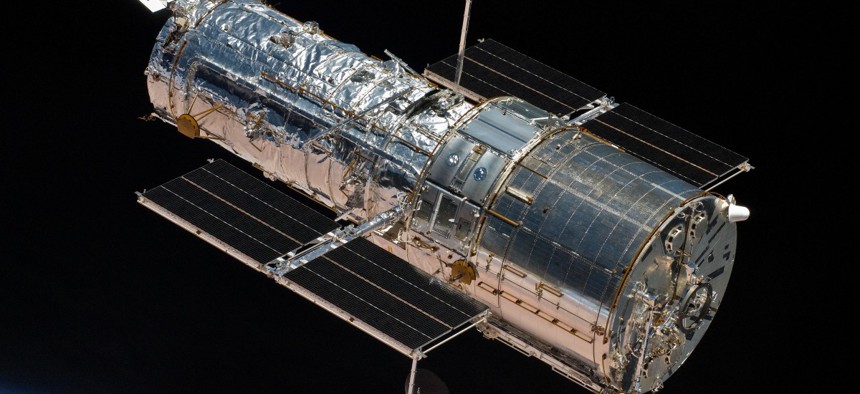NASA, SpaceX will Study Feasibility of Boosting Hubble Telescope Into Higher Orbit

NASA
The study will look at the possibility of moving Hubble into a more stable orbit, which would help extend the telescope’s life.
NASA and SpaceX will conduct a study to look at the feasibility of using SpaceX’s Dragon spacecraft to boost NASA’s Hubble Space Telescope into a higher, more stable orbit, which could extend its lifespan, according to an announcement on Thursday.
Currently, 32-year-old Hubble—which is set to retire at the end of the decade—is orbiting about 335 miles above Earth. However, the orbit is “slowly decaying over time” because of atmospheric drag, so boosting Hubble to a higher, more stable orbit could add several operational years to its life. Since 2009—the last time the telescope was serviced—it has moved about 18 miles lower.
SpaceX proposed this study to NASA in partnership with its Polaris Program—billionaire Jared Isaacman’s human spaceflight program—to better understand the technical challenges of a servicing mission. The study, which will collect technical data from Hubble and SpaceX’s Dragon spacecraft, is expected to take up to six months to complete. In particular, data from the study will help to determine if it is viable to “safely rendezvous, dock and move the telescope into a more stable orbit.”
“This study is an exciting example of the innovative approaches NASA is exploring through private-public partnerships,” NASA’s associate administrator for science, Thomas Zurbuchen, said.
“SpaceX and the Polaris Program want to expand the boundaries of current technology and explore how commercial partnerships can creatively solve challenging, complex problems,” said Jessica Jensen, vice president of customer operations and integration at SpaceX. “Missions such as servicing Hubble would help us expand space capabilities to ultimately help all of us achieve our goals of becoming a space-faring, multiplanetary civilization.”
According to NASA, the agency and SpaceX signed an unfunded Space Act Agreement last week. NASA noted that the agency does not have plans to conduct or fund a mission or go through with moving Hubble, instead emphasizing that this is a study that will examine the commercial possibilities.
“I want to be absolutely clear,” Zurbuchen said at a press conference on Thursday. “We’re not making an announcement today that we definitely will go forward with a plan like this.”
Additionally, this study is not exclusive, so other companies can “propose similar studies with different rockets or spacecraft as their model.” Rather, the focus is on exploring the possibilities.
In regards to what the study will examine, Jensen noted that it is mostly looking at technical aspects, but “we’re going to look at all the different options. At this point, everything is on the table. That’s part of feasibility studies, and that’s part of development.” According to Jensen, for example, the study could indicate that crewed missions are not necessary.
As part of the study, NASA and SpaceX will theorize a method to raise Hubble to its initial orbit of 373 miles above Earth, with a commercially-crewed Dragon capsule to service the telescope. If the original altitude is achieved, NASA estimated that it could extend the life of Hubble by 15 or 20 years.
Hubble was first launched into orbit in 1990, with a planned lifespan of approximately 15 years. The telescope has since more than doubled that estimate.
At the end of Hubble’s life, the agency plans to safely deorbit and dispose of the telescope. Last year, the agency launched Hubble’s successor, the James Webb telescope, which orbits much further away from Earth and is not intended as a wholesale Hubble-replacement. Webb produced its first images earlier this year.



